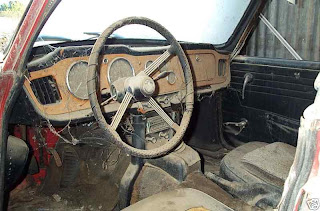Before I begin, I do have some newses for you. The little news: In real-time, just the exhaust, gas tank, and miscellaneous suspension parts need sandblasting and painting before I can start the ‘Put It Back Together’ phase of my Master Plan. The big news: The body has been painted, ready for delivery. Keeping you in suspense a little bit, here’s a glimpse: The finished hood (can’t see the red pearl coat in the picture, though).

Back to the Past. From previous posts, we’re pretty close to having everything disconnected from the body to, eventually, remove it. Right now, in blog time (sometime around early April ’09), our checklist looks something like this:
- Top: Removed
- Hood: Removed
- Trunk Lid: Removed
- Windshield: Removed
- Interior: About halfway
- Gas Tank: Later
- Engine/Brake/Clutch Controls: Later
- Wiring: Later
- Headlamps/Grill: Later
- Bumpers: Later
- Fenders: Later
- Doors: Later
- Carriage Bolts: Later
This is all just to remove the body (sounds like a lot, but it really isn’t). The engine, transmission, differential, and suspension will be dealt with after the body’s gone.
If you’re ready to begin, drain your radiator. If this seems weird to you, then you may need to think about things a little. Remember when you disconnected the heater control valve in ‘Misses Dash - Interior Part II’? Well, that heater valve just controls how much heated coolant is siphoned off the engine to your heater core to provide you with your desired amount of heat. It’s called coolant, but smart folks long ago decided to use it as a heat source too and they’re still doing it. All your heater really is is another, albeit small, radiator that transfers your engine’s heat to warm the air passing through it. So drain your radiator. There will be residual coolant in the hoses and core, but draining your radiator will stop the coolant from coming out of the engine while you’re working on the heater. Got it? Good.
Bonus Material: You might want to flush the system to clean it out beforehand. Depending on how long the car sat, your flushing agent could be just plain tap water or specialty chemicals designed to attack corrosion and gunk in there.
After the coolant is drained and stored in a safe place (pets love to drink antifreeze, but it’ll kill them), start detaching the hoses from the engine. The top hose is attached to the heater control valve, the other hose connects to a pipe that plumbs its way back to the water pump housing. If the clamps are frozen or stripped and the hoses are cracked or damaged, you can cut them - be sure to have something to catch the residual coolant in. When the hoses are disconnected, push them down as far as you can (without crimping them completely closed) to drain what’s in there. After they stop dripping, you can remove the other ends from the coupler that goes through your firewall.
Tech Tip: Get a radiator hose pick tool. It’s just an angled pick with a grip handle on it that you insert between the hose and neck and work it around until the hose is free. This is more for the benefit of the necks than the hoses because most necks that you come across will be copper-based, which is great for heat conduction, but not so great for strength. The pick will save the pliable necks on your radiator, heater core, and pass-through coupler regardless of whether you plan on keeping the hoses or not. A box cutter can be used as a last resort, just watch your fingers, please.
Moving inside the car, go to where the coupler passes through the firewall and disconnect the hoses from it. One thing to remember: The hose from the control valve goes to the top pipe that passes through the firewall, which connects to the hose that goes to the bottom of the heater core on the other side (the hoses cross here). This doesn’t help you at all now, but it will help when you’re putting everything back together. Now, just undo the retaining bolts at the top of the heating unit and set it aside to be dealt with later.
I know you’ve been patient; now, you can remove those pesky seats. There are four bolts holding each in place and you need to tilt both seats forward to find them. See – they’re nestled away in the seat rails. Not much wisdom to offer here, other than making sure that you label/mark the seats for ‘Driver’ and ‘Passenger’ because there are small differences. We’ll tear them down and reupholster them in a later post, but if you want to go with a less-expensive and easier option, junkyards or the Internet may have what you’re looking for: Miata seats. From the research I’ve done, seats from a Miata are the best-fit, modern-day seats for the TR. You can probably find nice, heated, electric, leather Miata seats for what the vinyl seat covers for the original TR4A seats would cost. Since I’m going stock-ish with leather and I like that the original seats don’t come above the door line, I can’t skimp. Your choice, though.
That’s it for now. I think we’ll follow our checklist above and move on to some of those other items next time… Bon Voyage.























.jpg)



























